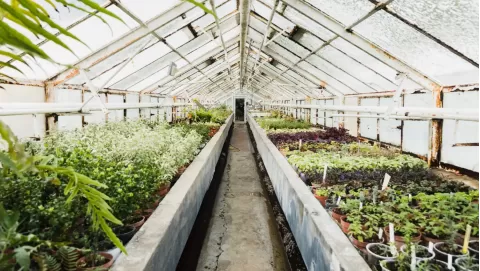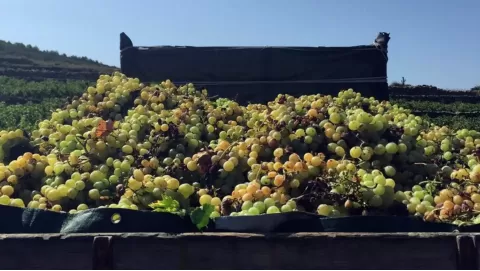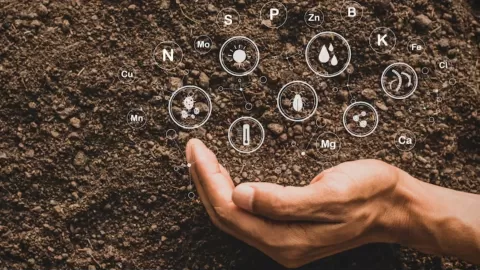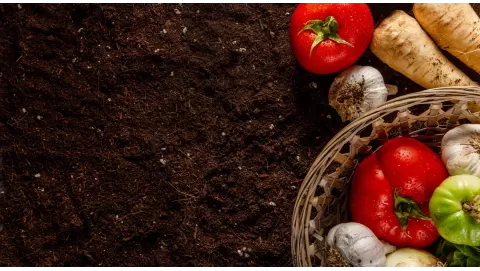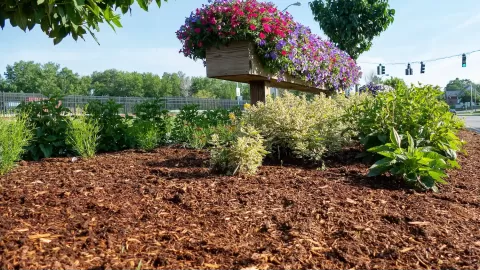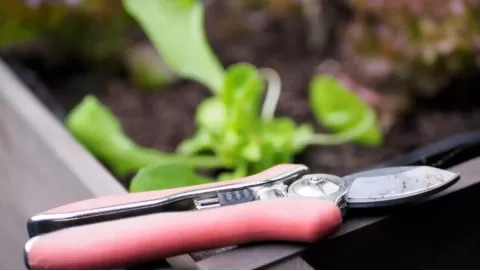
Vermiculite: Improve soil aeration and water retention for healthier plants
Healthy soil is vital for a healthy ecosystem as it promotes longevity and provides a habitat for plant growth. Soil health is often maintained by using several other mineral resources that are inexpensive and easily available. One of the solutions that can improve soil quality is vermiculite.
Natural, unique, vermiculite has gained huge popularity among gardening supplies. It's a soil amendment that improves the ability of the soil to support plant growth by increasing the levels of nutrients, water and oxygen in the soil. Soil health directly affects plants' absorption of these essential minerals.
Growcycle produces different types of vermiculite products to improve soil in gardening and hydroponic growing.
Vermiculite and its Properties
Vermiculite is a naturally occurring mineral that expands when it is heated. It is a part of a category of soft silicate minerals that crystallize in layers. Vermiculite flakes puff up to look like tiny sponges when used at high temperatures, a process known as exfoliation. As a result, the material becomes light, airy and absorbent.
If a rock is composed of minerals such as mica, then minerals that break down under heat, weather, and chemical change can be transformed into vermiculite. These alterations transform the rock into soft, layered minerals that store water in their structure. Vermiculite starts as a mined mineral, but when it is heated in purpose-built furnaces, it spreads up to 15 times its original size and takes on a lightweight, sponge-like shape. Vermiculite has several important properties, such as:
- Lightweight: It is low in weight and doesn't add to soil bulk when incorporated.
- Heat-resistant: It has a very high melting point and can be used in both gardening and construction.
- Absorbent: It can hold water and nutrients and release them slowly to plant roots when needed.
- Non-toxic and sterile: Safe to use around plants, pets, and people.
- pH neutral: Will not alter the acidity or alkalinity of the soil.
Due to these characteristics, vermiculite is popular in the fields of gardening as well as seed starting, hydroponics, packaging, and insulation.
The Science Behind Soil Aeration & Water Retention
Good soil is composed of a combination of minerals (like sand, silt and clay); organic material (such as decayed leaves or compost); air, water and living organisms. Soil structure describes how these pieces are organized. Soil with a well-balanced structure has spaces, or pores, to hold both air and water. These pores are crucial. Big pores allow air to move through the soil, while small pores hold water for plant roots.
Organic matter is also a big player in soil health. It improves soil structure, enhances water-holding capacity and provides food for beneficial microorganisms. As organic matter decomposes, it takes on a sponge-like quality that keeps the soil damp but not soggy.
Role of Aeration in Plant Growth
Soil aeration is the measure of how air can move in the soil and deliver oxygen to plant roots. As all organisms do, plant roots require oxygen in order to live. Without enough oxygen, roots can smother and that can stifle growth, turn leaves yellow and eventually kill a plant.
Roots can “breathe” when the soil is well-aerated, taking in the oxygen they require. A well-aerated environment also encourages roots to grow deeper and stronger, enabling access to higher quantities of water and nutrients.
Water Retention Mechanisms
In soil, water is as critical as air. Plants absorb water through their roots and require a constant flow to transport nutrients, for photosynthesis and remain hydrated. But an imbalanced amount of water can negatively affect the plant’s health.
Water is retained in the tiny gaps between particles in soil. There are different types of soil, and they hold water differently. For instance, sandy soil dries easily and retains little moisture, while clay soil has plenty of water but can get waterlogged and suffocate roots. The key is to keep enough water for the roots to take up, but not so much that the roots are sitting in it.
How Vermiculite Improves Soil Aeration
Vermiculite is a naturally occurring mineral that expands into this accordion-like layered structure when heated. When heated in processing, it puffs into light-weight, sponge-like pieces that are full of little air pockets. This air pocket is a critical factor for soil aeration improvement.
When mixed into soil, vermiculite adds space between soil particles and allows air to move more freely around a plant’s roots. In compacted or dense soils (e.g. clay), air circulation is poor because there are not enough spaces for the oxygen to flow. Adding vermiculite loosens the soil’s structure, preventing compaction and increasing local oxygen availability.
Impact on Root Health
Soil that breathes well promotes stronger roots and gives rise to a healthier and stable plant. With improved aeration, plants can better uptake nutrients and fight diseases associated with compacted soil.
Hydroponic and seed-starting operations also use vermiculite for its superb air-holding and water-retention characteristics. It’s widely employed to start seeds and root cuttings, providing fine roots a cushy, oxygenated medium to sprout in.
Integration Techniques
For soil with vermiculite to work well, it is necessary to mix it properly. Here are a few best practices for integration:
- For general garden beds or containers: Aerate soil using a shovel or till and mix vermiculite evenly into the top 6–12 inches of soil. Use 25–50% excerpt to soil weight depending on the weight of existing soil. Heavier or clay soils have a higher requirement for vermiculite.
- For seed starting or rooting cuttings: Mix fine to medium-grade vermiculite with peat moss in a 1:1 ratio, or use vermiculite on its own. This allows for great aeration and delicate moisture for tender roots.
- For lawn care or top dressing: Apply a thin layer (about 0.25–0.5 inches) of vermiculite to the soil and lightly rake it in. Surface aeration is enhanced, aiding in seed germination.
- For large pots and planters: Blend coarse vermiculite into potting soil to enhance drainage and air circulation. It’s also good to layer at the bottom of containers to help with drainage and also air flow from underneath.
Enhancing Water Retention with Vermiculite
One of the most beneficial attributes of vermiculite is its water retention properties. Vermiculite has a spongy texture due to its layered structure, which allows it to absorb moisture. When mixed with soil, it absorbs water and serves as a reservoir, allowing for a slow release of water as the surrounding soil dries. This provides a constant source of moisture to the roots of plants.
The tiny spaces inside each expanded vermiculite particle hold water and nutrients. These spaces retain moisture and distribute it evenly throughout the soil, minimizing dry patches and maximizing soil moisture content. This is particularly useful for container plants, raised beds and garden spots that dry out quickly.
Sandy soils, which drain water too quickly and clay soils, which retain water but become saturated, can be supplemented with vermiculite to keep a balanced playing field. It enhances water retention in sandy soils and promotes distribution in heavy, sticky soils, allowing plants to access the moisture they crave.
Effects of Drought on Drought-Prone Gardens
Vermiculite is a plant lifesaver in areas with limited rainfall or inconsistent watering. Its ability to hold water helps reduce the frequency of watering, which is important during hot, dry seasons or in drought-prone regions. Gardeners and farmers in dry climates often use vermiculite to help plants survive periods of water stress.
Vermiculite also has some distinct advantages over other moisture holding materials like peat moss or coconut coir.
- Peat moss retains water but can harden and become water-repelling when it dries completely.
- Coconut coir is more sustainable and distributes moisture evenly but may require additional nutrients.
- Vermiculite, in contrast, retains water in addition to aiding nutrient retention by slowly releasing both back into the soil.
Practical Tips and Best Practices
Vermiculite is simple to use, but choosing the right one as well as its proper application can significantly level up the vermiculite game. Whether a gardener is working in a small container garden or a large backyard plot, following some simple steps can enable plants to grow better and healthier.
How to Choose the Right Vermiculite Product
Different grades of vermiculite refer to the size of its particles. Each grade is suitable for particular types of gardening tasks:
- Fine Grade: This grade is suitable for starting seeds, rooting cuttings, or small potted plants. It retains water very well and has a fine texture that cushions tender seedlings.
- Medium Grade: These are for general gardening use, typically to help eliminate pests. Effective in houseplants, flower beds, and vegetable gardens.
- Coarse Grade: Most suitable for larger containers, raised beds, or outdoor gardens with heavier soils. It gives drainage and prevents soil from being too compacted.
Here are some things to look for when selecting vermiculite:
- Crushed, heat treated vermiculite (for absorbance and cleanliness).
- Sealed and dry packaging, free of mold or moisture.
- This is a no-dust product, because the cheaper ones can have far too much dust that makes it messy and uncomfortable to work.
Application Methods for Different Garden Types
The growing setup used can make a significant difference in the plant performance when it comes to knowing how to use vermiculite.
1. Container Gardening
- Combine potting soil and vermiculite in a ratio of 3:1.
- For moisture-loving plants (ferns or calatheas, for example), add double vermiculite to 50 percent.
- Always have pots with good drainage holes. Vermiculite retains a fair amount of water, which can lead to overwatering issues in containers.
2. Raised Bed
- Mix 1 part vermiculite with 2–3 parts compost or topsoil.
- Work it into the top 6–12 inches of soil to promote both water retention and air flow.
- That’s particularly useful in hot areas where the soil dries out fast or in clay-dominant soil that becomes compacted.
3. In-Ground Gardens
- In planting season, mix vermiculite with the topsoil.
- For vegetables, flowers, or shrubs, 4–6 liters of vermiculite per square meter of garden space is recommended.
- It reduces water runoff and dry patches, particularly on slopes or uneven terrain.
4. Seed Starting & Propagation
- Apply pure vermiculite to the seeds after sowing them. This process moistens the surface and helps the seeds to germinate more quickly.
- Use a 1:1 weight ratio of vermiculite and peat moss for rooting plant cuttings. The mix retains moisture but has plenty of air space in which to grow roots.
5. Lawns and Ground Covers
- Over newly sown grass seeds, place a very thin layer of vermiculite on top to retain moisture and protect them against birds or wind.
- As the seeds germinate, lightly water the area, keeping the vermiculite damp.
Troubleshooting Common Issues
While the vermiculite is extremely helpful, there are some usual errors that gardeners ought to look for:
1. Over-Retaining Water
Vermiculite traps a lot of water, so too much can make the soil soggy, particularly in pots or poorly-drained regions. This can cause:
- Root rot
- Fungal growth
- Slow plant growth
Always follow correct mixing ratios and make sure pots and garden beds have drainage.
2. Uneven Mixing
If vermiculite is unevenly incorporated into the soil it results in too wet or too dry patches. Before planting, mix vermiculite into the soil with a garden fork or hand trowel.
3. Choosing the Wrong Grade
In large, outdoor gardens, fine vermiculite may compact, minimizing air flow. However, coarse vermiculite alone might not retain enough moisture for seed trays. Grade the application fine for seeds, medium for general use, and coarse for outdoor beds.
FAQs
Does vermiculite improve aeration?
Yes, vermiculite aids in the aeration of the soil. Their light, open structure creates small air pockets in the soil that help roots breathe more easily. This poses less suitability for root rot and encourages good root growth. It is especially useful on dense or compacted soil.
Is vermiculite good for water retention?
Absolutely. Vermiculite holds many times its weight in water. It gradually delivers moisture back to plant roots as needed, maintaining overall soil dampness and decreasing the frequency of watering.
How does vermiculite help plants?
It makes soil structure better, keeps water and can store nutrients close to the roots. It also promotes healthy air flow and root growth. When plants receive the correct balance of water, air, and nutrients, they grow bigger and healthier.
The Bottom Line
As a natural mineral, vermiculite improves soil health and is crucial to growing healthy plants. It possesses special qualities like aeration, water retention, and nutrient holding capability, making it one of the best materials to be mixed with the natural garden soil. Applying vermiculite helps gardeners improve air flow, retain moisture, and assist with nutrient absorption.
It is also easy to work with and can help ensure optimal growing conditions. By selecting only the best quality products, such as those offered by Growcycle, plants get the best care possible, maximizing their growth potential. Moreover, it is an organic gardening alternative that is safe and environmentally friendly.
Disclaimer: This material is for informational purposes only and should not be relied on for legal, medical, financial, or any other form of professional advice.


